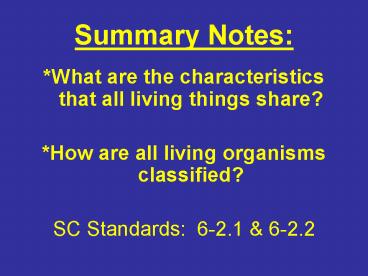Summary Notes: - PowerPoint PPT Presentation
1 / 34
Title:
Summary Notes:
Description:
Summary Notes: *What are the characteristics that all living things share? *How are all living organisms classified? SC Standards: 6-2.1 & 6-2.2 – PowerPoint PPT presentation
Number of Views:92
Avg rating:3.0/5.0
Title: Summary Notes:
1
Summary Notes
- What are the characteristics that all living
things share? - How are all living organisms classified?
- SC Standards 6-2.1 6-2.2
2
What do all of these things have in common?
3
What are the characteristics of ALL living things?
- They obtain and use resources for energy.
- They respond to stimuli.
- They reproduce.
- They grow and develop.
- They have cells and are organized.
4
They obtain and use resources for energy
- All organisms must obtain (get) resources, which
provide energy to perform the basic functions of
life. - In other wordswe need to get food and water in
order to grow and develop!
5
- Plants are autotrophs, which means they make
their own food for energy through photosynthesis. - Most other organisms are heterotrophs, which
means they must find an external source for food. - Very few organisms that are not plants may use
photosynthesis.
6
Got Energy?
7
2. Organisms respond to stimuli
- A Stimulus is any change in an organisms
surroundings that will cause the organism to
react. - Examples of environmental stimulus
- Changes in amount of light, Temperature, Sound,
Amount of water, Space, Types of food present
8
- The reaction to a stimulus is called a response.
- This can be an action or behavior performed by
the organism. - Non-living things do not respond to environmental
changes this way.
9
For Example
- Stimulus
Response
Your Sister smells the cookies and comes running!
You bake cookies
10
Another Example
- Stimulus
- Plant feels bug
- Response
- Plant traps bug
11
3. They reproduce.
- Organisms have the ability to reproduce or
produce offspring that have similar
characteristics as the parents. - Two ways to reproduce
- Sexual
- Asexual
12
- Sexual involves 2 parents, a female-egg,
male-sperm, egg and sperm combine to make an
offspring that is different from both parents. - Asexual a reproductive process that involves
only one parent that produces offspring that are
identical to the parent.
13
Types of Reproduction
- Asexual Reproduction
- Sexual Reproduction
14
4. They grow and develop.
- Growth is the process by which an organism
becomes larger or gains more cells. - Development is the process that occurs in the
life of the organism that results in the organism
becoming more complex structurally. - Remember All organisms require energy to grow
and develop!!
15
Growth and development
16
5. They are organized.
- All organisms are made of cells.
- The cell is the smallest unit of an organism that
carries on the functions of life. - Some organisms are unicellular or composed of
just one cell - While others are multicellular or composed of
many of the same cell or many different types of
cells.
17
All living things have cells
- Cell without a Nucleus
- Cell with a nucleus
18
How are all living organisms classified?
- Classification or taxonomy? a system of
categorizing organisms based on shared observable
characteristics. - You use a dichotomous key, a series of yes or no
questions that are opposites. - Remember you can use a dichotomous key to
categorizing living AND non-living things!
19
- Classification for living things?
- kingdom broadest
- phylum
- class
- order
- family
- Genus
- species most specific
20
- ? Broadest level
- ? Referred to as divisions in the plant kingdom.
There are 35 different phyla in the animal
kingdom. - Contains closely related organisms.
- ? Consists of all organisms of the same type
which are able to breed and produce young of the
same kind.
21
(No Transcript)
22
- KINGDOM
- Broadest level
- Organisms are placed into kingdoms based on their
ability to make food or not and the number of
sells in their bodies. - Most scientists support a 5 kingdom system
(plants, animals, fungi, protista monera
kingdoms)
23
- PLANT KINGDOM
- Multicellular
- Autotrophs
- reproduce sexually, asexually, or both.
24
Plants
25
- ANIMAL KINGDOM
- Multicellular
- Heterotrophs
- reproduce sexually
26
Animals
27
- FUNGUS KINGDOM
- can be either unicellular OR multicellular
- Heterotrophs (must get energy from feeding on
living or dead organisms) - Can reproduce sexually or asexually
28
FUNGI
29
- PROTIST KINGDOM
- unicellular or multicellular
- heterotrophs or autotrophs (some are capable of
making their own food through photosynthesis and
others must feed on other organisms) - reproduces sexually
30
Protist
Diaton (below)
Algae (below)
Euglenoid (below)
Amoeba (below)
31
- MONERA KINGDOM
- all bacteria belong to this kingdom
- Unicellular
- do not have a cell nucleus
- Some are autotrophs through photosynthesis, and
some are heterotrophic - reproduce asexually
32
Monera A.K.A Bacteria
33
- SCIENTIFIC NAME
- Made up of the organisms Genus and species
- It is written in italics (Genus species) with the
genus capitalized and the species in lower case - Example Homo sapiens
34
Classification of a Jaguar
- Kingdom Animalia
- Phylum Chordata
- Class Mammalia
- Order Carnivora
- Family Felidae
- Genus Panthera
- Species onca
- What is the jaguars scientific name?































